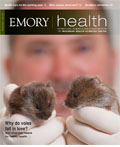Cancer' sweet tooth may be weakness
 |
Like cranky children clamoring for a candy bar, cancer cells crave sugar.
Scientists who study cancer have known for decades that cancer cells tend to consume more glucose, or blood sugar, than healthy cells, but they haven’t figured out a way to exploit cancer cells’ collective sweet tooth.
Now a team led by Emory’s Winship Cancer Institute has identified an enzyme called PKM2, which governs cancer cells’ preference for glucose and may be a valuable anti-cancer drug target. The results were published November 2009 in the journal Science Signaling.
Cancer cells prefer to turn glucose into energy with a process known as glycolysis, says hematology/oncology researcher Jing Chen. This tendency is known as the “Warburg effect,” honoring Otto Warburg, a German biochemist and 1931 Nobelist
Normally, cells have two modes of burning glucose, which are comparable to sprinting and long-distance running: glycolysis, which doesn’t require oxygen and doesn’t consume all of the glucose molecule, and oxidative phosphorylation, which requires oxygen and is more thorough in its consumption.
Cancer cells benefit from glycolysis because they often outgrow their blood supply and their easy access to oxygen, Chen says. They also benefit from glycolysis because leftovers from the inefficient consumption of glucose can be used as building blocks for growing cells quickly.
Chen and his colleagues focused on PKM2 (pyruvate kinase M2) because it controls whether cells make the switch between glycolysis and oxidative phosphorylation. PKM2 is found predominantly in fetal and tumor cells.
In many types of cancer, proteins called tyrosine kinases became overactivated. Chen’s team showed that tyrosine kinases turn off PKM2 in lung, breast, prostate, and blood cancers. Introducing a form of PKM2 that is insensitive to tyrosine kinases into cancer cells forces the cells to grow more slowly and be more dependent on oxygen, they found.
Because the active form of PKM2 consists of four protein molecules stuck together, having a tyrosine kinase flip the “off” switch on one molecule can dampen activity for others.
“People knew for decades that tyrosine kinases might modify PKM2, but they didn’t think it mattered,” Chen says. “We showed that such a modification is important. You even don’t need that much modification of PKM2 to make a difference in the cells’ metabolism.”
PKM2 could be a good drug target to slow down cancer cell growth. Activating PKM2 would force cells to grow more slowly—as in Chen’s experiment—and blocking it completely could also impede cells from processing nutrients. Biotechnology companies are already searching for ways to do both, Chen says. —Quinn Eastman


